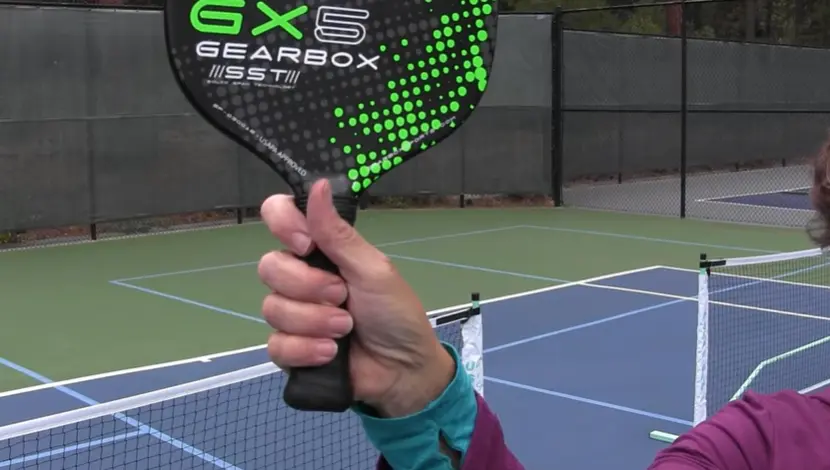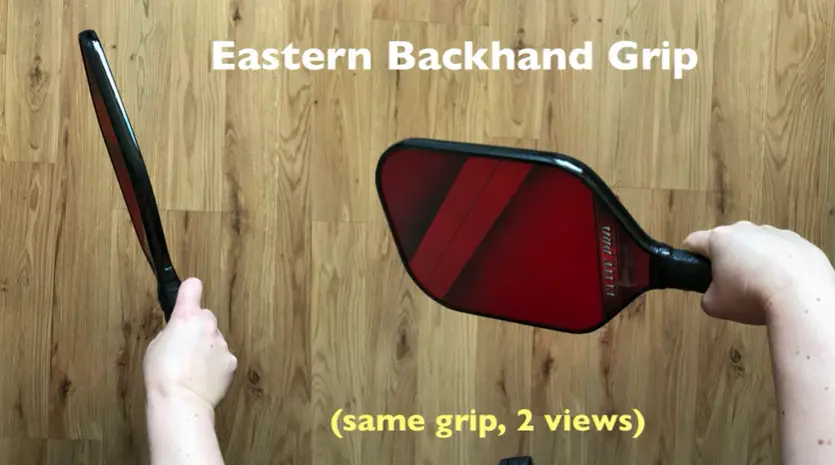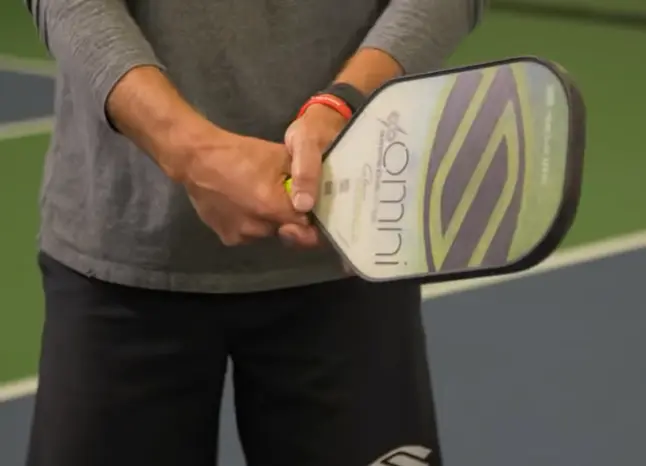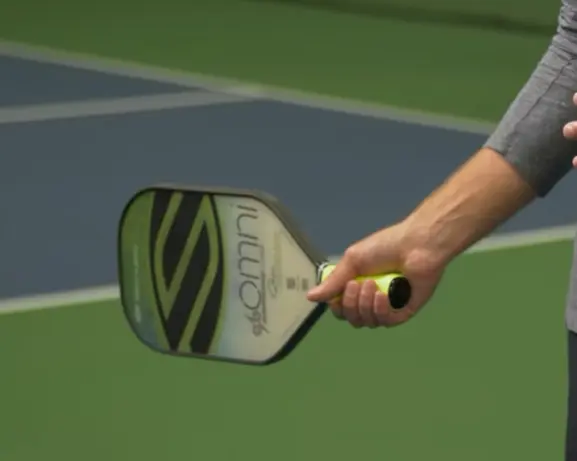Whether you’re a beginner or an experienced player, understanding the proper way to hold a pickleball paddle can greatly impact your game. As a pickleball player myself, I’ve learned that the grip you use can affect your mechanics, game style, and comfort level.
In this article, I will explain the three most common grips used in pickleball and guide you in choosing the best grip for you. By holding the paddle correctly, you can develop good habits from the start and improve your game overall.
Plus, with proper grip and technique, you can hit the ball where you want it on the court and win more points, especially in fast exchanges called hands battles.
Do Not Forget to Read: Latest Pickleball Paddles

I will also provide tips on starting from the best ready position, eliminating wasted movement, and covering the most shots in the least amount of time.
Whether you’re a lefty or righty, this article will give you the knowledge and skills to improve your pickleball game.
How To Hold A Pickleball Paddle
One of the most important aspects of playing pickleball is knowing how to hold the paddle correctly. Now, I will cover the best ways to grip a pickleball paddle and why it matters.
The Importance of Holding the Paddle Correctly
Holding the paddle correctly is crucial for several reasons. First, it can improve your performance in both forehand and backhand shots.
Second, it can help prevent injuries and strain on your hand and wrist. Finally, it can increase your overall enjoyment of the game by giving you more control over the ball.
Types of Grips
There are three main types of grips in pickleball: Eastern, Western, and Continental. Each grip has its own advantages and disadvantages, and the best grip for you will depend on your mechanics, game style, and comfort level.
Eastern Grip

The Eastern grip is the most common and recommended grip for new pickleball players. It is neutral and can be used for both forehands and backhands without changing your grip. To find the Eastern grip, place your hand flat on the face of the paddle and slide it down to the handle, resembling a handshake.

Western Grip
The Western grip is less common and resembles how you may hold a frying pan when flipping a pancake. The Western grip favors the forehand grip and offers a lot of spin but can set up a difficult angle for backhands.

To find the Western grip, start with the Eastern grip and rotate the paddle roughly 60-90 degrees toward the ground.
Continental Grip
The Continental grip plays into a player’s backhand more than their forehand and is common for blocking volleys at the kitchen line.

The Continental grip makes hitting a forehand difficult without changing your grip. To find the Continental grip, start with the Eastern grip, rotate the paddle 60-90 degrees in the opposite direction of the Western grip, and hold your hand over the edge of the paddle with your thumb and index finger on either side of the paddle.
Another way to find the Continental grip is to put your hand out as if shaking someone’s hand and then hold the handle, lining it up with the 2nd bevel.
How to Hold the Paddle
Once you have found the grip that works best for you, it’s important to hold the paddle correctly. Here are some tips:
- The paddle should rest more in your fingers than in the palm of your hand.
- You should have a loose grip on the handle, but it should be firm enough to prevent the paddle from falling out of your hand.
- Holding the paddle too tightly can reduce control and accuracy in your shots.
- Holding the paddle too loosely can result in the paddle falling out of your hand during play.
Further Information: How To Practice Pickleball Alone
The Role of the Index Finger in Pickleball: Tips for Holding Your Paddle
Holding the paddle correctly is one of the most critical aspects of playing pickleball. The position of the index finger on the paddle plays a crucial role in the grip, control, and accuracy of your shots.
When holding a pickleball paddle, the position of the index finger on the handle can make a significant impact on your game. The index finger provides stability, balance, and control in your shot execution.
When holding your pickleball paddle, it is essential to maintain a firm grip with the index finger while remaining relaxed. Gripping the paddle too tightly can lead to a decrease in control and accuracy in your shots. A firm grip will provide the necessary stability and balance needed for precise shot execution.

It is also essential to pay attention to the position of your index finger during different shots. For example, during a forehand shot, the index finger should be on the bottom of the handle, while during a backhand shot, the index finger should be slightly more towards the top of the handle.
By adjusting the position of your index finger, you can improve your shot execution and overall gameplay.
Do Not Forget to Read: How To Clean Pickleball Paddle
Do’s and Don’ts of Pickleball Paddle Holding
I will explore the do’s and don’ts of holding a pickleball paddle to help players improve their gameplay.
Do: Use a proper grip.
Using the correct grip is essential in pickleball. The most common grip used is the “continental grip,” where the index finger is on the bottom of the handle and the other fingers wrapped around it.
It is essential to ensure that your grip is comfortable and relaxed, yet firm enough to control the paddle during gameplay.
Don’t: Grip the paddle too tightly
While it is important to have a firm grip on the paddle, gripping it too tightly can negatively impact your gameplay. An overly tight grip can lead to stiffness in the wrist and elbow, leading to a decrease in accuracy and control during swings. It is essential to maintain a relaxed grip on the paddle to avoid this issue.
Do: Adjust the grip for different shots.
Adjusting the grip on the paddle is important for executing different shots. For example, during a forehand shot, the index finger should be on the bottom of the handle, while during a backhand shot, it should be more towards the top of the handle. By adjusting the grip, players can maintain control and accuracy in their shots.
Don’t: Use too much wrist.
While it may be tempting to use the wrist to generate power in your shots, this can be detrimental to your gameplay. Overusing the wrist can lead to injury and decrease the accuracy of your shots.
It is important to use a full arm swing, involving the shoulder and elbow, to generate power and maintain control over the paddle.
Do: Use proper posture.
Proper posture is essential to maintaining balance and control during gameplay. Players should keep their feet shoulder-width apart, knees slightly bent, and their weight evenly distributed. This position allows for quick movements and effective shot execution.
Don’t: Hold the paddle too far from the body.
Holding the paddle too far from the body can lead to a loss of control and accuracy in shots. It is important to keep the paddle close to the body to maintain control and balance during swings.
Do Not Forget to Read: Can You Play Pickleball On A Tennis Court
Final Words
In conclusion, holding the pickleball paddle correctly is critical for players to improve their performance, prevent injuries, and enjoy the game more.
The Eastern, Western, and Continental grips are the most common ways to hold a pickleball paddle, and each has its own advantages and disadvantages. Players should choose the grip that works best for their mechanics, game style, and comfort level.
Once the grip is determined, players should focus on holding the paddle correctly, keeping a firm but relaxed grip, and adjusting the position of the index finger to improve shot execution.
Remember to use a proper grip, avoid gripping the paddle too tightly, and always remain relaxed. With these tips and practice, players can improve their gameplay and increase their chances of winning points in fast exchanges.

Michael Stevenson
Hi, my name is Michael Stevenson and I’m a passionate pickleball player. I’ve been playing the game for many years and I’m pretty highly skilled at it. Pickleball is one of my favorite topics so naturally, I love to write about it.
Whether it’s tips for beginners, guides for experts, reviews of new paddles, or advanced playing techniques – if it relates to pickleball then I have something interesting to write about it. So if you’re looking for entertaining and informative information on the topic of pickleball, look no further than my written works!